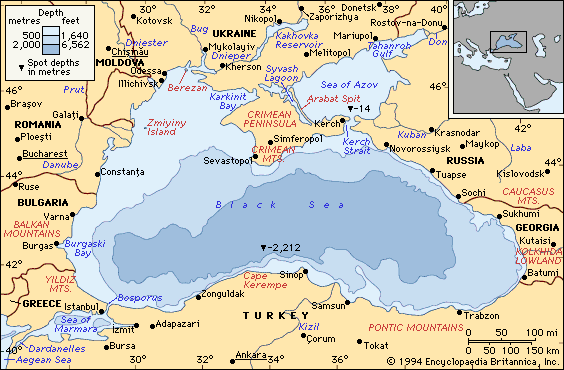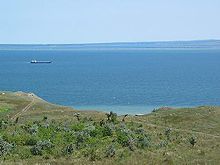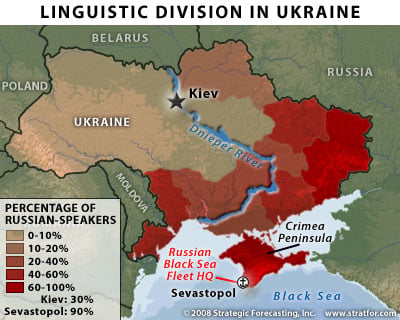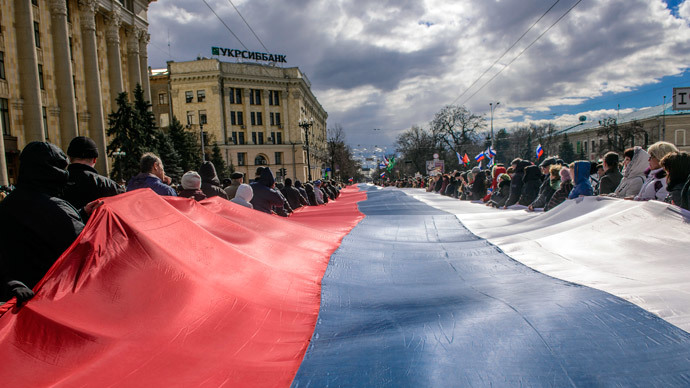Crisis in Ukraine: Russia Extends its Control over the Black Sea and Strategic Waterways

The union of Crimea with Russia redefines the geopolitical chessboard in the Black Sea Bassin.
It constitutes a major setback for US-NATO, whose longstanding objective was to integrate Ukraine into NATO with a view to undermining Russia and extending their military presence in the Black Sea bassin.
With the March 18, 2014 Treaty signed between Russia and Crimea, the Russian Federation will extend its control over the Black Sea as well over the Sea of Azov, the West coastline of which borders on Eastern Ukraine and the Donesk region. (see map below)
Under the agreement between Russia and Ukraine announced by president Putin, two “constituent regions” of Crimea will join the Russian Federation: the “Republic of Crimea” and the “City of Sevastopol”. Both will have the status of “autonomous regions”.
The status of Sevastopol as an autonomous entity separate from Crimea is related to the location of Russia’s Naval base in Sevastopol.
Since the break-up of the Soviet Union, Russia retained its naval base in Sevastopol under a bilateral agreement with Ukraine. With the signing of the March 18th Treaty, that agreement is null and void. Sevastopol including the naval base becomes an autonomous region within the Russian federation
Strategic Waterway: The Kerch Straits
Russia now formally controls a much larger portion of the Black Sea, which includes the entire Crimean peninsula.
The Eastern part of Crimea –including the Kerch straits– are now under Russian control. On the Eastern side of the Kerch straits is Russia’s Krasnodar region and extending southwards are the port cities of Novorossiysk and Sochi.
Novorossiysk is also strategic. It is at the cross-roads of major oil and gas pipelines between the Black Sea and Caspian sea.

 Historically, the Kerch straits have played a strategic role. They constitute a gateway to Russia’s major waterways.
Historically, the Kerch straits have played a strategic role. They constitute a gateway to Russia’s major waterways.During World War II, the Kerch peninsula occupied by Nazi Germany (taken back by the Red Army) was an important point of transit by land and water. In the coldest months of Winter, it became an ice bridge linking Crimea to the Krasnodar region.
The Kerch straits are about 5 kilometres in length and 4.5 km. wide at the narrowest point between the tip of Eastern Crimea and the peninsula of Taman, Kerch is a major commercial port linked to railway, ferry and river routes.
[image right: Kerch straits, photo taken from Crimean side, narrow width]
The Sea of Azov: New Geopolitical Hub
Of significance, the integration of Crimea into the Russian Federation means that Moscow is now in full control of the Kerch Straits linking the Black Sea to the Sea of Azov. The Ukrainian authorities are no longer in control of the port of Kerch. The bilateral agreement between Russia and Ukraine governing the maritime route through the Kerch straights has been scrapped.
The straits constitute an entry point into Russia’s major river waterways. The Sea of Azov connects with the Don River and the Volga, through the Volga Don Canal. In turn, the Volga flows into the Caspian sea.
The Kerch straits are strategic. The Kerch-Yenikalskiy Canal allows large vessels to transit from the Black sea to the Sea of Azov.

Moreoever, the Kerch Straits link the Black Sea to the Volga which in turn connects to the Moscow river through the Volga-Moskva canal.
Full control of the narrow Kerch straits by Russia ensures unimpeded maritime transit from the Black Sea to Russia’s capital as well as the maritime route to the Caspian Sea. (Black Sea- Sea of Azov -Don- Volga Don Canal -Volga -Caspian sea)
In December 2013 Moscow signed a bilateral agreement with the Yanukovych government in Kiev pertaining to the construction of a bridge across the Kerch Straits, connecting Eastern Crimea (which was part of Ukraine) with Russia’s Krasnodar region.
That agreement has also been scrapped. Crimea’s union to Russia was already in the pipeline: Less than two weeks before the March 16 Referendum, at the height of the crisis in Ukraine, Russia’s Prime Minister Dmitry Medvedev ordered the state-road building corporation Avtodor, or “Russian Highways” “to create a subsidiary company that will oversee the building of a bridge across the Kerch Strait”.
Needless to say, the project will now be fully under Russian ownership and control.
The Sea of Azov, Eastern Ukraine and the Donbas Region
The Eastern Ukraine and the densely populated Donetz basin (Donbas region) of Ukraine -in which the Russian population constitutes a majority– borders on the Western coastline of the Sea of Azov, which is now in large part under Russian control.

“Ripple Effect” of the Crimean Referendum. How will the Crisis Evolve?
Will the referendum in Crimea set the stage for the integration of part of Eastern and Southern Ukraine into the Russian Federation?
The geographic and geopolitical changes discussed above have a direct bearing on unfolding events in Eastern Ukraine. (see map above)
Throughout Eastern Ukraine as well as in Odessa in southern Ukraine, the legitimacy of the interim neo-Nazi government in Kiev has been questioned. Municipal and local levels citizens’ committees are challenging the authority of Kiev appointed officials.
In the port city of Odessa on the Black Sea, a protest movement demanding a referendum has unfolded.
Thousands held a Pro-Russian rally in support of Crimea’s referendum in Odessa, despite calls from the city’s authorities not to participate in meetings. Organizers claim more than 5,000 people joined the demonstration.Reported by RT, protests have developed in Kharkov and Donetsk demanding the holding of a referendum similar to that of Crimea.
“Odessa is against the coup in Kiev, paid for by the West and Ukrainian oligarchs who remained in power with the help deceitful extremists and militants. We are tired of living in poverty and we are no longer going to tolerate the tyranny of oligarchs and officials,” ….
The people were chanting “Ukraine and Russia – one country,” and “Odessa, be bold, drive the fascists out,” as they gathered in the center of the city. (RT, March 16, 2014)
Protesters, on behalf of Kharkov’s assembly, asked Putin to “guarantee their rights and freedoms” and pass to the United Nations their demands regarding a referendum on the federalization, which they plan for April 27, reported Ukrainian National News (UNN) website. Additionally, activists asked to deploy Russian peacekeepers to Kharkov region, adding that they fear for their lives and property.
The demonstrators then marched to the nearby consulate of Poland, protesting against Western interference into Ukrainian affairs.
Kharkov protesters also looted the building housing offices of radical-nationalist organizations, including the Right Sector group, reported Interfax-Ukraine. The activists broke into the building, took out books and nationalist symbols and burnt them.

Pro-Russian
activists hold giant Russian flags during their rally in the eastern
Ukrainian city of Donetsk on March 16, 2014.(AFP Photo / Alexander
Khudoteply)
In Donetsk, pro-Russian protesters questioned the legitimacy of the interim coalition government:Meanwhile, Kiev sent heavy military hardware to the borders with Russia. Activists in eastern Ukraine regions, including Donetsk and Lugansk, were reportedly blocking trains delivering military equipment from the central and western parts of Ukraine.Similar rallies were held in Dnepropetrovsk and Lugansk.
In Lugansk the campaign focused on a ‘people’s referendum’ directed against the Kiev interim government:
In Lugansk, several thousand anti-coup activists were conducting a public poll by handing out “ballot papers” of “people’s referendum” of Lugansk region. The poll raised questions of trust in the authorities in Kiev, the possibility of joining the Customs Union following the federalization of Ukraine.
One of the questions was about the international bailout: “Do you support reduction of social benefits and cancellation of benefits at the request of the IMF?”
“This is for all an opportunity to officially announce their choice. Now we have run out of 5,000 forms, we are rushing to print more,” organizer Irina Gotman told UNIAN. (RT, op cit)
No comments:
Post a Comment